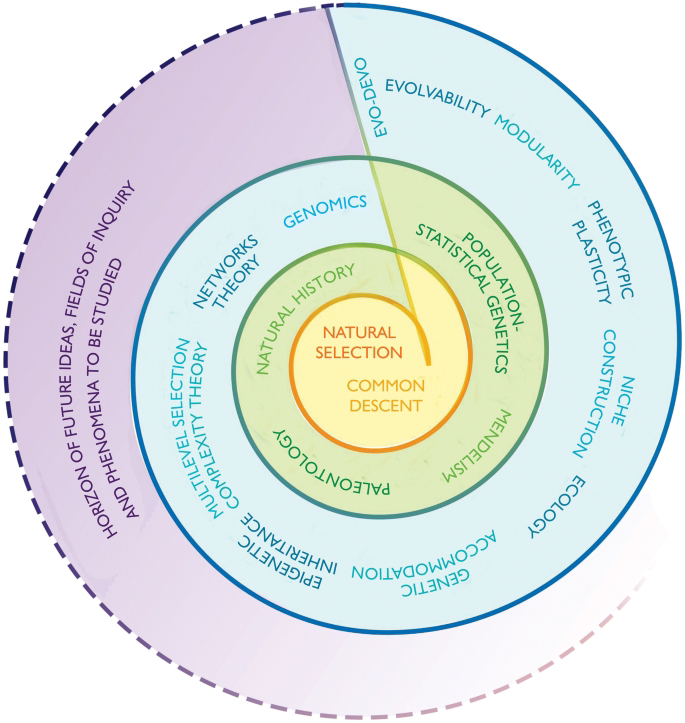Tenants of the Extended Evolutionary Synthesis: How it Differs from the Modern Synthesis
The Modern Synthesis (MS), which emerged in the mid-20th century, revolutionized our understanding of evolution by fusing Darwinian selection with Mendelian genetics. For decades, it stood as the dominant framework for explaining how life changes over time. However, in recent years, a growing body of research has challenged some of the MS's core assumptions, leading to the development of the Extended Evolutionary Synthesis (EES).
The EES expands evolution's scope to encompass a wider range of evolutionary phenomena. It incorporates insights from fields like developmental biology, epigenetics, and symbiosis, offering a more nuanced and comprehensive understanding of evolution.
Here, we'll explore some key tenants of the EES, highlighting how it diverges from the Modern Synthesis:
1. Beyond Genes: Focus on Phenotypes:
MS: Primarily focuses on changes in gene frequencies as the driver of evolution.
EES: Emphasizes the importance of phenotypes (observable characteristics) and their direct interaction with the environment. Phenotypic changes can precede and influence genetic changes.
2. Not Just Random Mutations:
MS: Views new variation arising primarily through random mutations in genes.
EES: Recognizes other sources of variation, such as epigenetic modifications, developmental bias, and horizontal gene transfer (transfer of genes between organisms).
3. More Than Just Selection:
MS: Natural selection acting on genes is the primary force driving adaptation.
EES: Acknowledges other evolutionary mechanisms, including genetic drift, niche construction (organisms modifying their environment), and symbiosis (mutually beneficial interactions between species).
4. Positive, Not Just Neutral Changes:
MS: Neutral theory suggests most mutations are neutral, with only a small portion affecting fitness.
EES: Proposes that many phenotypic changes are initially beneficial, providing a broader role for positive selection.
5. Beyond Gradualism:
MS: Favors gradual, incremental change as the dominant mode of evolution.
EES: Recognizes the potential for rapid bursts of evolutionary change through developmental switches, niche construction, and symbiosis.
6. The Role of Development:
MS: Largely overlooks the role of developmental processes in shaping phenotypes.
EES: Integrates developmental biology, recognizing how development can constrain or facilitate evolutionary change.
7. Epigenetics in the Driver's Seat:
MS: Ignores the potential for nongenetic inheritance through epigenetic modifications, the Weismann barrier.
EES: Recognizes the role of epigenetic mechanisms in influencing phenotype and potentially transmitting acquired traits across generations.
8. Symbiosis is Key:
MS: Primarily focuses on individual organisms and their adaptations.
EES: Emphasizes the importance of symbiosis in shaping evolution, with horizontal gene transfer playing a significant role.
9. Niche Construction Matters:
MS: Assumes the environment passively selects for pre-existing adaptations.
EES: Recognizes that organisms actively modify their environment, creating niches that favor their own evolution and that of other species.
10. Evolution is Not Just About Genes:
MS: Views genes as the primary units of selection and evolution.
EES: Proposes that larger units, such as genomes, cell lineages, and even entire ecosystems, can also be units of selection.
11. Convergent Evolution is More Common:
MS: Views convergent evolution (similar traits evolving in unrelated lineages) as rare and primarily due to similar selective pressures.
EES: Recognizes that convergent evolution is more common than previously thought, potentially driven by developmental constraints and niche construction.
12. Evolution is Not Always Adaptive:
MS: Assumes that most evolutionary changes are adaptive, increasing an organism's fitness.
EES: Acknowledges that some changes may be non-adaptive or even maladaptive, with neutral drift playing a significant role.
13. Evolution is Repeatable:
MS: Views evolution as a largely unpredictable and contingent process.
EES: Proposes that certain evolutionary patterns, such as convergent evolution and developmental biases, can be more predictable and repeatable.
14. Open-Ended Evolution:
MS: Often portrays evolution as a process leading to increasing complexity and adaptation.
EES: Recognizes that evolution can also lead to simplification, degeneration, and even extinction, with no predetermined endpoint.
15. From Populations to Individuals:
MS: Primarily focuses on population-level changes in gene frequencies.
EES: Recognizes the importance of individual variation and selection within populations, with stochasticity playing a significant role.
These are but a few of the differences between the MS and the EES. A thought leader in evolutionary theory, EV Koonin, says,
"The summary of the state of affairs on the 150th anniversary of the Origin is somewhat shocking: in the post-genomic era, all major tenets of the Modern Synthesis are, if not outright overturned, replaced by a new and incomparably more complex vision {EES} of the key aspects of evolution. So, not to mince words, the Modern Synthesis is gone.”
252,652 citations by scientists!




Comments
Post a Comment